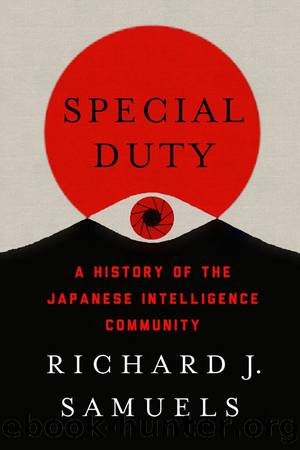Special Duty by Richard J. Samuels;

Author:Richard J. Samuels;
Language: eng
Format: epub
Publisher: Lightning Source Inc. (Tier 3)
Published: 2019-07-03T00:00:00+00:00
Military Intelligence
As examined in chapter 3 of this volume, CIROâs rather odd situation originated in highly charged debates over civilian control in the 1950s. So, despite quietly standing up its own Military Affairs Unit, and despite being assigned nominal responsibility to supervise the CSIC, CIRO had little military expertise well into the 2010s.95 In the intervening years, however, proper military intelligence was enhanced considerably.
HUMINT
We can begin to review Japanâs military intelligence during this period with Japanâs widely acknowledged lack of HUMINT resourcesâparticularly the sorts of foreign area experts discussed in chapter 2 who were so numerous and skilled before and during the Asia-Pacific War. It was not only CIRO and MOFA that had to play catch-up in this domain. The militaryâs own language and analytic skills training program also had to be reorganized in March 2001, when two smaller training centers were combined in western Tokyo to create a successor to the Nakano Schoolâthe Kodaira School.96 This was a delicate problem because, as one senior MOD intelligence officer uncomfortable with transparency explained: âThe almost complete lack of clandestine collection overseas has been criticized by the LDPâfirst by Machimura⦠. But a bill authorizing such HUMINT would invite a very active political circus and would likely produce an intrusive accountability mechanism that would stifle any new intelligence organization. So on HUMINT we needed to start small and evolve over time.â97 Even if on a small scale, experience accumulated for military intelligence. There were unconfirmed press reports in 2013 that the GSDF was funding agents run by Kodaira Schoolâtrained handlers in Russia, China, and elsewhere.98
But the largest and fastest-growing number of active foreign area intelligence collectors were the military attachés of the SDFâmostly officials from the Second Section of the Investigation Division of the Ground Self-Defense Force who operated in the open.
After the Kodaira School was initiated and the supply of foreign area officers began to increase, the SDF broadened its reach. It began placing military attachés in such nations as Saudi Arabia, Vietnam, Ukraine, Syria, Afghanistan, Kuwait, Sudan, Kazakhstan, Lebanon, Algeria, Ethiopia, Kenya, Djibouti, Nigeria, and Morocco. Since many of these were sites of multinational peacekeeping missions, it was relatively easy to justify the increased attention. Nor, given the shift in the regional balance of power, were increases in the number of military attachés sent to China and South Korea hard to explain to budget examiners or the general public. The government also found it useful to take advantage of defense attachés and liaison officers dispatched to the U.S. Pacific Fleet, the Pentagon, or other billets as resources.99 During the compilation of the 2015 budget, amid editorials calling for enhanced intelligence capabilities, MOD announced plans to send additional defense attachés to Mongolia, the UAE, and Jordan. In an uncanny echo of Nomonhan (see chapter 2), Mongolia was described by an unnamed official as a âparticularly important platform for intelligence gatheringâ because of its borders with Russia and China and its diplomatic relations with North Korea.100
Table 5.2 Japanâs Intelligence Attachés Abroad
Download
This site does not store any files on its server. We only index and link to content provided by other sites. Please contact the content providers to delete copyright contents if any and email us, we'll remove relevant links or contents immediately.
| Espionage | Hoaxes & Deceptions |
| Murder & Mayhem | Organized Crime |
| Serial Killers | White Collar Crime |
Mindhunter: Inside the FBI's Elite Serial Crime Unit by John E. Douglas & Mark Olshaker(8707)
Wiseguy by Nicholas Pileggi(5320)
Hitman by Howie Carr(4830)
Room 212 by Kate Stewart(4741)
Secrecy World by Jake Bernstein(4390)
Killers of the Flower Moon: The Osage Murders and the Birth of the FBI by David Grann(4191)
Breaking Free by Rachel Jeffs(4013)
Papillon (English) by Henri Charrière(3908)
Killers of the Flower Moon by David Grann(3753)
Say Nothing by Patrick Radden Keefe(3726)
American Kingpin by Nick Bilton(3510)
The Secret Barrister by The Secret Barrister(3423)
Molly's Game: From Hollywood's Elite to Wall Street's Billionaire Boys Club, My High-Stakes Adventure in the World of Underground Poker by Molly Bloom(3337)
Mysteries by Colin Wilson(3253)
In Cold Blood by Truman Capote(3140)
I'll Be Gone in the Dark by Michelle McNamara(2888)
Signature in the Cell: DNA and the Evidence for Intelligent Design by Stephen C. Meyer(2879)
Rogue Trader by Leeson Nick(2829)
Bunk by Kevin Young(2809)
